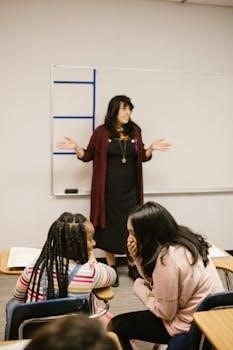Eleven by Sandra Cisneros⁚ Questions and Answers
This section will explore common inquiries about Sandra Cisneros’s short story, “Eleven.” We will delve into the nuances of the narrative, examining themes of identity, age, and power dynamics. This analysis will provide clear answers based on the text and critical interpretations of the story.
Summary of the Plot
The short story “Eleven” by Sandra Cisneros centers around Rachel, a young girl on her eleventh birthday, experiencing a day that starkly contrasts with her expectations. The narrative unfolds in her classroom where a red, old sweater is discovered. Despite Rachel’s denial, her teacher, Mrs. Price, insists the sweater belongs to her, attributing it to a previous incident. This forces Rachel to wear the unpleasant sweater, leading to a deep sense of humiliation and injustice. The story uses this event to showcase Rachel’s inner turmoil as she navigates the complex emotions of feeling younger than her age, experiencing a sense of vulnerability, and her struggle with the power dynamics in the classroom. Rachel’s emotional response culminates in tears, a visible display of her distress. Even when another classmate claims the sweater, the teacher doesn’t acknowledge Rachel’s feelings, further demonstrating the powerlessness she feels. The narrative concludes with Rachel longing for the day to end, encapsulating the challenges of growing up and navigating societal expectations. This birthday experience becomes a pivotal moment in Rachel’s understanding of herself and the world around her.

Themes of Identity and Age
“Eleven” poignantly explores the intricate relationship between identity and age through Rachel’s experiences on her birthday. Cisneros masterfully illustrates that growing older is not a linear progression, but a layered accumulation of past selves, each age still residing within. Rachel’s internal monologue reveals her struggle to reconcile her eleven-year-old self with the younger versions she still embodies. She expresses how feeling scared or crying like a younger child can surface despite her chronological age. This idea of layered identity is reinforced by the metaphors of an onion, tree rings, and nesting dolls, symbolizing the multifaceted nature of personal growth. The story also examines how external perceptions of age can clash with internal feelings. Rachel’s desire to be seen and understood for who she is, rather than just her age, highlights the challenges of self-discovery. The red sweater incident acts as a catalyst, exposing her vulnerability and the pressures she faces to conform to societal expectations. The narrative emphasizes that identity is fluid and complex, shaped by both internal and external forces, and how growing up is a non-linear process.
The Red Sweater Symbolism
The red sweater in “Eleven” serves as a potent symbol, embodying multiple layers of meaning within the narrative. Primarily, it represents conformity and the pressure to adhere to societal expectations. Rachel’s reluctance to claim the unattractive, worn sweater stems from her fear of judgment and desire to fit in. The sweater is not just an article of clothing; it becomes a symbol of the unwanted attention and ridicule she anticipates. It signifies the discomfort and injustice she experiences when forced to wear it, highlighting the conflict between individuality and conformity. Furthermore, the red sweater represents a loss of agency and power. Rachel’s inability to assert her truth and the teacher’s dismissive attitude towards her protests underscore the power dynamics at play. The sweater also acts as a symbol of humiliation and vulnerability, exposing Rachel’s emotions to the entire class. Its unpleasant smell and worn appearance further amplify her discomfort, making it a tangible representation of her emotional state. In essence, the red sweater is a catalyst that brings to the surface the complex feelings associated with growing up and the challenges of asserting one’s identity in the face of external pressures.
Character Analysis of Rachel
Rachel, the protagonist of “Eleven,” is a complex and relatable character whose inner world is revealed through her first-person narration. She is an introspective young girl, deeply aware of her own feelings and the layered nature of her identity. Her reflection on the concept of age, and how it doesn’t make her feel older, showcases her unique perspective. Rachel is portrayed as vulnerable, experiencing a range of intense emotions as she navigates the challenges of her eleventh birthday. Her sensitivity is evident in her reaction to the red sweater, which triggers feelings of injustice and embarrassment. She is also shown to be resilient, even in the face of humiliation, highlighting her inner strength. Rachel’s desire for empathy and understanding is clear, as she yearns for someone to see her for who she is. Despite her vulnerability, she demonstrates a keen awareness of the complexities of her identity. She struggles with conforming to external expectations, but maintains an inner sense of self. Her authentic voice allows the readers to connect with her experiences of growing up and her internal conflict. Ultimately, Rachel is a character that encapsulates the emotional journey of a young girl on the cusp of adolescence.
Narrative Perspective and Voice
Sandra Cisneros employs a first-person narrative in “Eleven,” allowing readers direct access to Rachel’s thoughts and feelings. This narrative choice is crucial to understanding the story’s emotional depth and impact. Rachel’s voice is authentic and relatable, capturing the inner world of a young girl on the cusp of adolescence. The use of the first-person perspective creates a sense of intimacy, drawing readers into Rachel’s personal experiences. Her voice is characterized by introspective observations, vividly describing the way she perceives the world around her. The narration reflects her vulnerability, as she expresses her insecurities and longing for understanding. Through her voice, we witness her struggle to reconcile her past selves with her current age. Rachel’s perspective is distinctly that of an eleven-year-old, marked by her unique insights into the complexities of growing up. The narrative voice also allows Cisneros to explore themes of identity, vulnerability, and power dynamics through Rachel’s personal lens. The informal tone and simple language used mirror a young person’s way of expression, making her experiences even more relatable.

Literary Devices Used by Cisneros
Cisneros masterfully employs several literary devices to enhance the emotional impact and thematic depth of “Eleven.” Metaphor is a prominent tool, with the comparison of growing older to an onion, tree rings, and nesting dolls effectively illustrating the layered nature of identity. These metaphors emphasize that each age remains within an individual, shaping their current self. Sensory imagery is used to create vivid scenes, such as the description of the red sweater, making the story more immersive. Symbolism is also significant, with the red sweater representing conformity, societal expectations, and the pressure to fit in. The sweater symbolizes the conflict between authenticity and external judgments. Personification is used to deepen the understanding of Rachel’s emotions, describing how her “five-year-old” self feels scared and her tears sound like “animal noises.” Repetition is employed, particularly the phrase “not mine,” to highlight Rachel’s internal conflict and her struggle to assert her individuality. These devices work together to create a rich and complex narrative.

The Significance of the Title ‘Eleven’
The title “Eleven” holds profound significance, extending beyond a mere reference to the protagonist’s age. It encapsulates the core theme of the story⁚ the complex nature of growing up. The title highlights that turning eleven doesn’t automatically make one feel older or more mature; instead, it suggests that at any given age, individuals carry their past experiences and emotions within them. This layered understanding of personal growth is central to the story’s message. Moreover, “Eleven” signifies a transition and a liminal space, representing the threshold between childhood and adolescence. It marks the beginning of a new life stage, where the protagonist faces new challenges and responsibilities. The title serves as a constant reminder that this particular age is a crucial milestone in personal development. The title, therefore, becomes a symbol of the intricate journey of self-discovery and emotional navigation inherent in the process of aging.

Power Dynamics in the Story
The narrative of “Eleven” is significantly shaped by power imbalances, particularly those between adults and children. Mrs. Price, the teacher, embodies an oppressive authority figure who diminishes the protagonist’s agency. She dismisses Rachel’s protests about the red sweater, forcing her to accept it and wear it, thereby undermining the young girl’s voice and feelings. This dynamic illustrates the powerlessness often experienced by children in the face of adult authority. The story underscores how adults can wield their power to impose their will, often disregarding the emotional turmoil and vulnerability of children. The inability of Rachel to challenge or resist Mrs. Price’s authority accentuates her lack of control over the situation. The incident highlights a power imbalance that stifles the protagonist’s self-expression and reinforces the idea that the voices of children are often marginalized or ignored, leading to feelings of injustice and frustration. This is a key element in the story.
Emotional Impact and Vulnerability
The story “Eleven” deeply explores the emotional landscape of its young protagonist, Rachel, highlighting her vulnerability in the face of an unjust situation. The forced wearing of the red sweater triggers a cascade of negative emotions, including embarrassment, discomfort, and a profound sense of injustice. Rachel’s internal struggle is palpable as she tries to suppress her true feelings, ultimately leading to an emotional outburst in front of her classmates. Her tears reveal the depth of her vulnerability and the pain she experiences when her voice is ignored and her feelings are dismissed. The narrative emphasizes the emotional toll of suppressing one’s true self to meet external expectations. Rachel’s longing for understanding and empathy underscores the universal need for acceptance, especially during the sensitive transition from childhood to adolescence. The experience leaves her feeling trapped and resigned, highlighting the lasting emotional impact of the incident.
Interpretation of Growing Up Metaphors
Cisneros masterfully employs metaphors to illustrate the complex and layered nature of growing up in “Eleven.” The comparison of age to an onion, with its multiple layers, suggests that each year of life is not discarded but rather added to the previous ones, shaping one’s identity. Similarly, the image of tree rings emphasizes the accumulation of experiences over time, each ring representing a distinct phase of life. The metaphor of nesting dolls further reinforces the idea that past versions of ourselves remain within us, influencing our present selves. These metaphors highlight the non-linear and cumulative nature of personal development, where past emotions and experiences continue to shape our perceptions and responses. This layered approach shows how a person can simultaneously feel like a child and an adolescent, thus making the protagonist’s emotions more relatable. This use of metaphors allows readers to connect to the complexities of aging.

Leave a Reply
You must be logged in to post a comment.